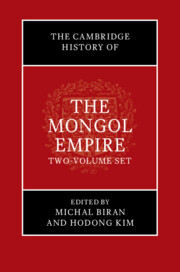Book contents
- The Cambridge History of the Mongol Empire
- The Cambridge History of the Mongol Empire
- Copyright page
- Dedication
- Contents
- Figures in Volume I
- Figures in Volume II
- Maps in Volume I
- Maps in Volume II
- Tables in Volume I
- Contributors to Volume I
- Contributors to Volume II
- Acknowledgments
- Notes on Dates and Transliterations
- Abbreviations
- Volume I
- Introduction
- Volume I Part 1 Political History
- Volume I Part 2 Thematic Histories
- 6 Mongol Imperial Institutions
- 7 Imperial Ideology
- 8 The Military Machine
- 9 Economic Exchange
- 10 Religious Exchange
- 11 Scientific Exchange
- 12 Artistic Exchange
- 13 The Climate and Environment of the Mongol Conquest
- 14 Women and Gender under Mongol Rule
- Volume I Part 3 Views from the Edges
- Volume I Part 4 External Histories
- Epilogue
- Volume II
- Index to Volume I
- Index to Volume II
- References
8 - The Military Machine
from Volume I Part 2 - Thematic Histories
Published online by Cambridge University Press: 01 January 2024
- The Cambridge History of the Mongol Empire
- The Cambridge History of the Mongol Empire
- Copyright page
- Dedication
- Contents
- Figures in Volume I
- Figures in Volume II
- Maps in Volume I
- Maps in Volume II
- Tables in Volume I
- Contributors to Volume I
- Contributors to Volume II
- Acknowledgments
- Notes on Dates and Transliterations
- Abbreviations
- Volume I
- Introduction
- Volume I Part 1 Political History
- Volume I Part 2 Thematic Histories
- 6 Mongol Imperial Institutions
- 7 Imperial Ideology
- 8 The Military Machine
- 9 Economic Exchange
- 10 Religious Exchange
- 11 Scientific Exchange
- 12 Artistic Exchange
- 13 The Climate and Environment of the Mongol Conquest
- 14 Women and Gender under Mongol Rule
- Volume I Part 3 Views from the Edges
- Volume I Part 4 External Histories
- Epilogue
- Volume II
- Index to Volume I
- Index to Volume II
- References
Summary
The Mongol military centered on armies of decimally organized mobile horse archers. This system provided the Mongols with both a rationally organized military and a means of incorporating defeated enemies, as soldiers now belonged to units of a thousand rather than retaining old tribal identities. As the Mongol Empire expanded, new groups joined their ranks and the Mongols found new ways of accommodating them into their war machine without fundamentally disrupting their own ways of war. The Mongols also realized that regional needs sometimes dictated the use of other forces. Siege engineers, infantry, heavy cavalry, and naval forces all found use within the Mongol military. The Mongols showed flexibility not only in using personnel and military units, but also in adopting technologies, including gunpowder. After the dissolution of the United Mongol Empire, Mongol armies primarily fought each other in internecine wars. It became increasingly difficult to share training, technology, and personnel.
- Type
- Chapter
- Information
- The Cambridge History of the Mongol Empire , pp. 460 - 487Publisher: Cambridge University PressPrint publication year: 2023
References
- 1
- Cited by

